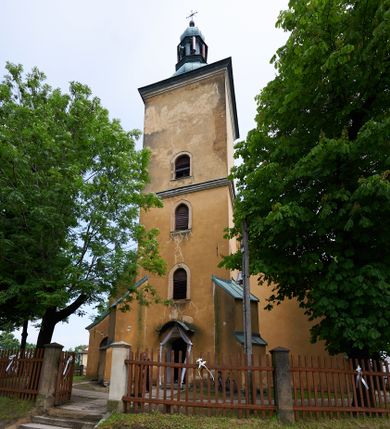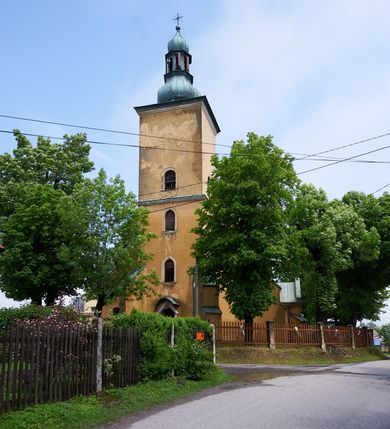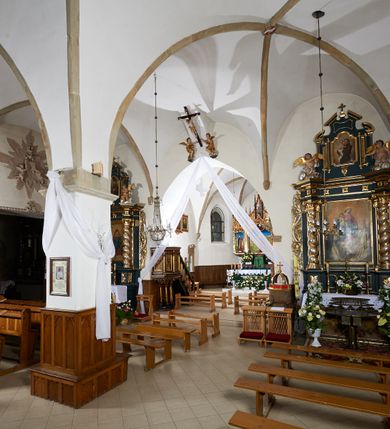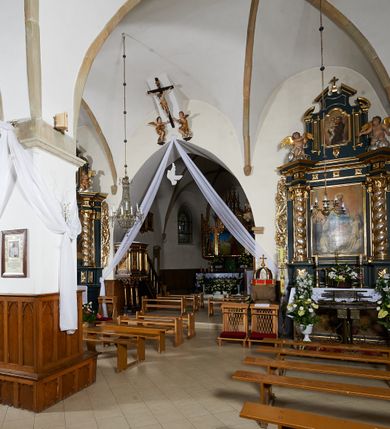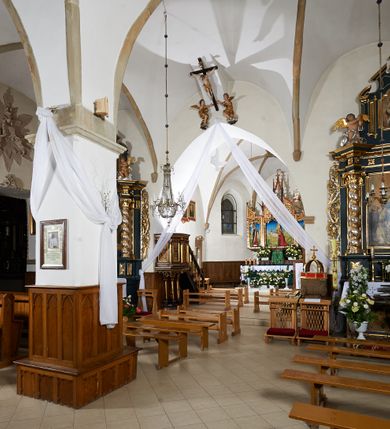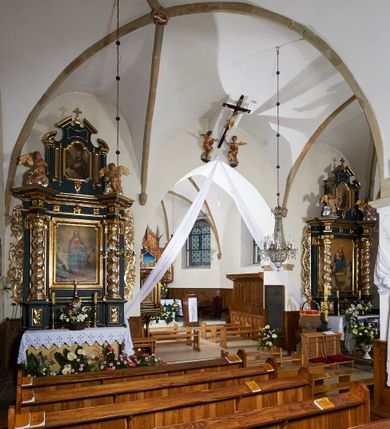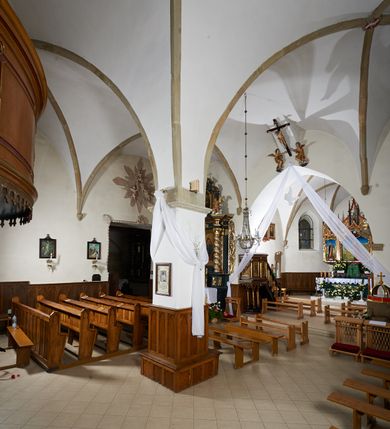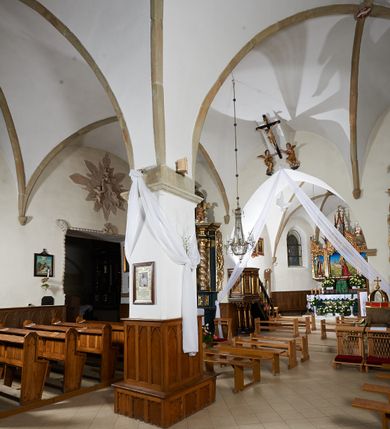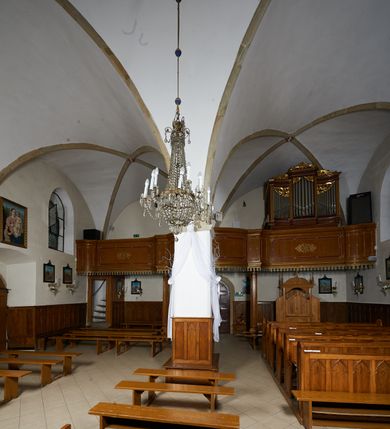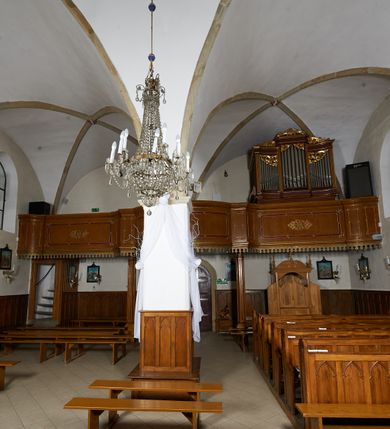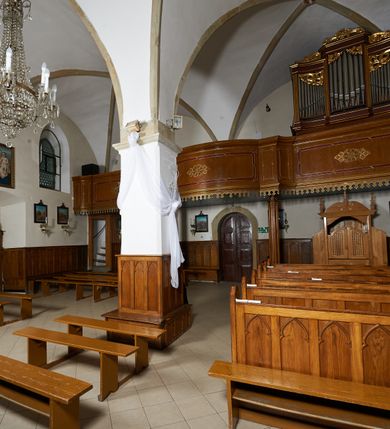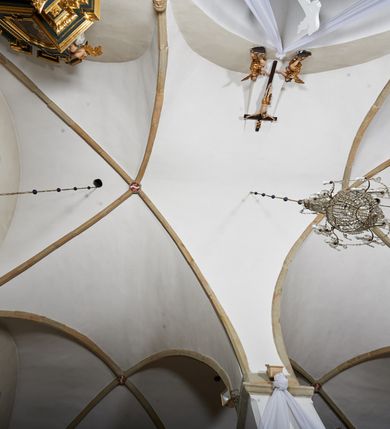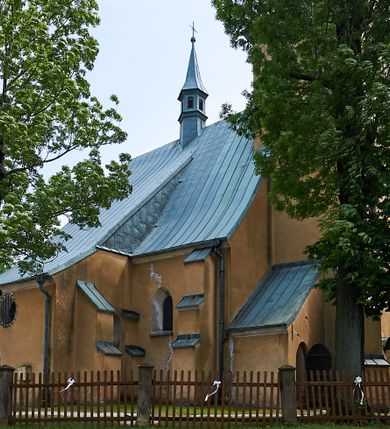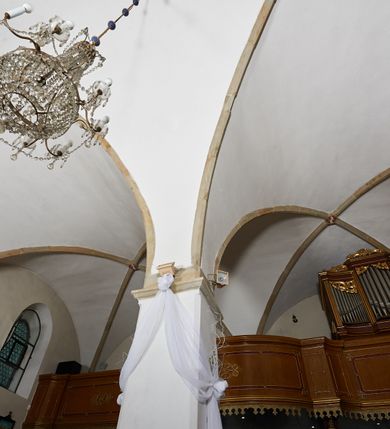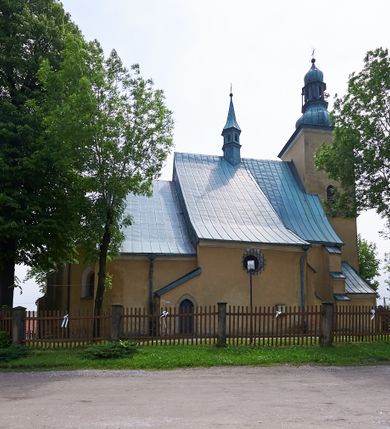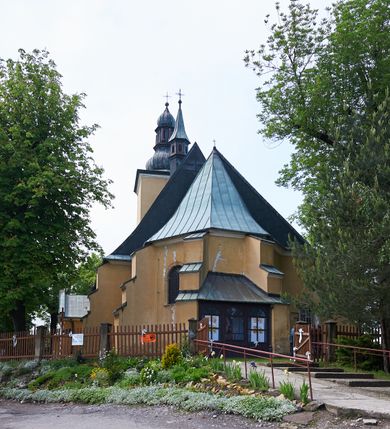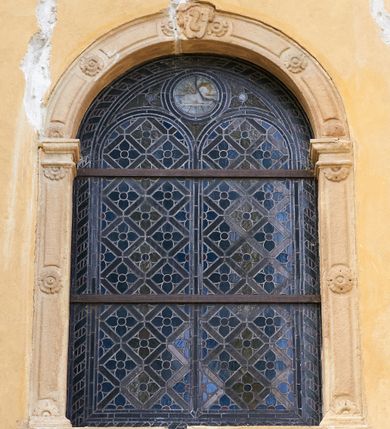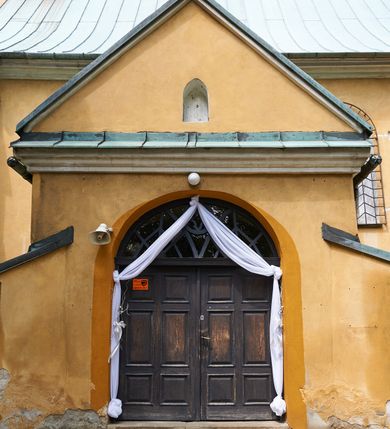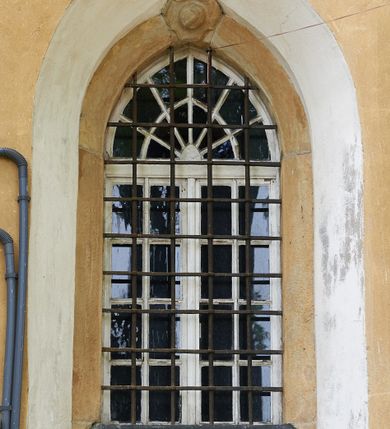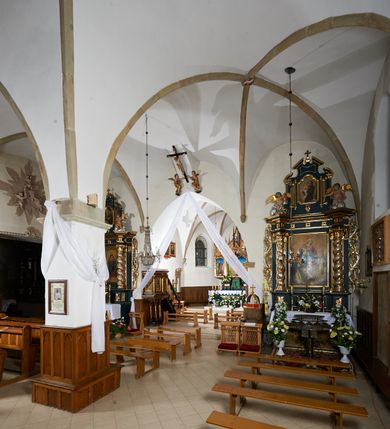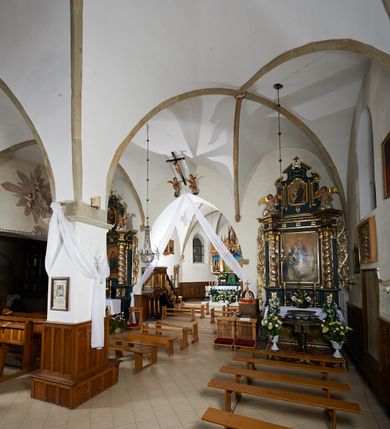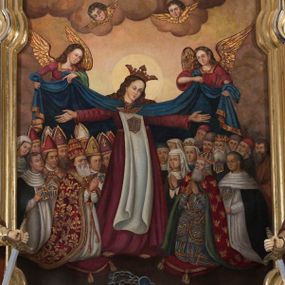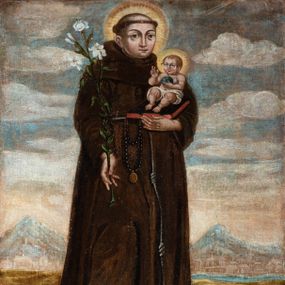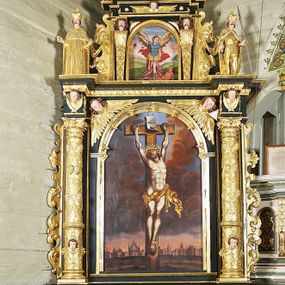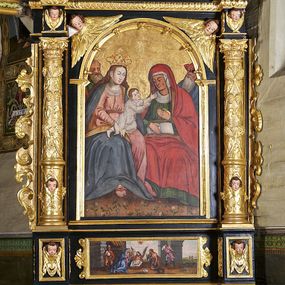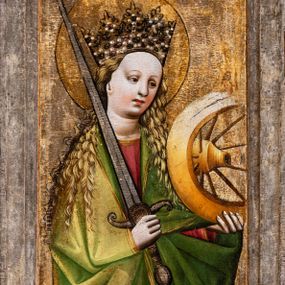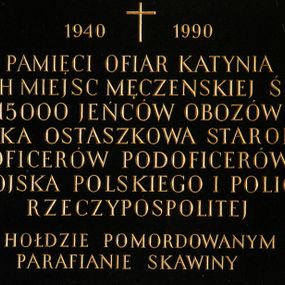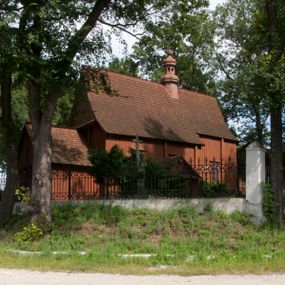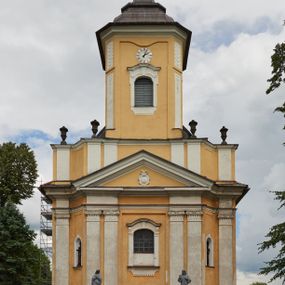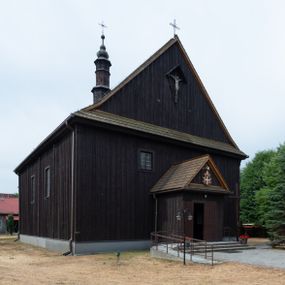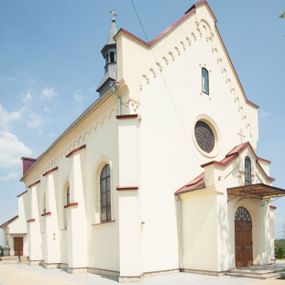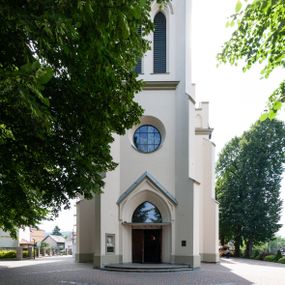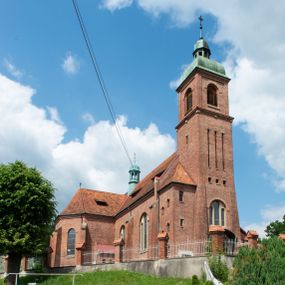
Church of the Discovery of the Holy Cross
Place
Łazany
Parish
Holy Cross parish in Łazany
Identifier
DZIELO/22061
Amount
1
Catalogue note author
Justyna Kuska
History of work
The original church of the Finding of the Holy Cross in Łazany was mentioned in the years 1325-1327. In the 15th century, there was a wooden temple in the town, which did not differ significantly in size from the currently existing church. It was probably an oriented building with a square or rectangular nave with a long, rectangular chancel closed on three sides and a sacristy from the north. The front elevation was probably accentuated by a post and beam structure tower with a suspended bell chamber. From the text of the visit of the Bishop of Cracow, Cardinal Jerzy Radziwiłł, one can learn that it existed in 1597, and around it the walls of a new, stone temple were built. Construction of the new church began in 1586, but it is difficult to clearly determine the date of its completion. The literature on the subject often provides information that the construction of a stone temple in Łazany was carried out in the years 1586-1590. However, it seems that the work was performed over a longer time. The church was consecrated in 1594. Undoubtedly, in 1618 the building was already completed, because in the next episcopal visit we are already talking about a stone, consecrated temple with a chapel and a stone tower. Shortly after the construction of the church was completed, a magnificent late-Renaissance tombstone of Jakub Lubomirski, the parish priest in Łazany and Sebastian Lubomirski, patron and founder of the local church, was placed in its side chapel. Thanks to the information contained in subsequent canonical visits, it is known that the temple equipment at the beginning of the 17th century included four stone altars, most likely one in the chancel and one in the side chapel, and two on both sides of the chancel arch. In addition, in the chancel there were a pair of four-seat choir-stalls with Mannerist features, of which one, now moved to the side chapel, have survived to this day. A pulpit could have been built in the similar style which was removed in 1898 due to poor condition. On the axis of the church, in front of the chancel wall, there was a stone baptismal font, preserved to this day and decorated with the coats of arms of Junosza, Doliwa, Ślepowron and Lis. In the second half of the 17th century, after the Swedish invasion, the temple was in poor condition, in particular suffered the bell tower, belfry and cemetery fence. Severe damage was repaired thanks to the efforts of parish priest Michał Michałowski and the sums recorded in the will of the then owner of the village, Stanisław Samuel Kalinowski. The beginning of the eighteenth century brought further destruction, this time resulting from the Northern War (1700-1721). In a visit from 1703, a mention was made of "a floor made of stone, uneven and many stone pieces cracked [...] the church is covered with brick tiles, but the cement does not connect well, is washed, so the cracks are visible and some beams have been damaged [...] ] the roof of the church and belfry maintained, in many places rotting and broken, because its brick tile soaked with water [...] ". In this document, in addition to the description of the poor condition of the church in Łazany, for the first time there is also a detailed description of all the altars in the temple. The high altar was dedicated to the Holy Cross and contained a picture of the Crucifixion in the main field. The coping is adorned by the Resurrection scene. Side altars, set at the chancerl arch were dedicated to St. Anne (left altar) and Our Lady of Częstochowa (right altar). In the side chapel there was an altar of St. Stanislaw, not existing anymore, in which was placed a damaged and faded picture painted on a wooden board (probably imagining the patron of the retable). The coping was a painting depicting the scene of Resurrection of Piotrowin (preserved, currently in the coping of an altar transported from Wieliczka and placed in the place of St. Stanislaw's retable). The decor of the temple in Łazany changed significantly in the second half of the 18th century, during the rule of two parish priests Józef Świeradowski (1724-1742) and Antoni Wojciechowski (1742-1752). The first of them ordered a new high altar which not lasted till today, made in polychrome, silvered and gilded, which was flanked with gates containing figures of St. Peter and St. Mary Magdalene. The main field of this retable was a sculptural image of the Crucifixion scene. Świeradowski also funded two side altars that have survived to this day, which have retained invocations for earlier retables. The form of these altars with a pair of spirally twisted columns capturing the main field, a cornice diagonally broken, a painting depiction in the co;ping and a broken abutment in closing was modeled on the equipment of the collegiate church of St. Anna in Cracow, which had to be attended by priest Świeradowski, professor of theology at the University of Cracow. The changes also affected the side chapel, in which the stucco decorations existing above the entrance were made and the stucco altar dedicated to the Virgin Mary, located opposite the St. Stanislaw retable (demolished in 1897). In the second half of the 19th century, priest Ludwik Navarra (1852-1894), to whom the temple owes a thorough renovation performed the service in the church in Łazany. Thanks to the efforts of the parish priest of Navarre, the ties and roofing were replaced, the font was repaired, the loft was supported, the floor was replaced, new organs were built, and the high altar and the pulpit were renovated. In the 1880s, the church was plastered again and the nave was whitewashed. In the Artistic and Glass Plant in Cracow run by Teodor Andrzej Zajdzikowski, medieval stained glass windows were ordered. The same style was applied in the new high altar, funded by the then owner of the village, Julian Dunin-Brzeziński, and made by sculptor Kazimierz Wakulski, according to the design by Tadeusz Stryjeński. Another parish priest, Franciszek Błachut, renovated the side altars, and also asked the Cracow architect and conservator Sławomir Odrzywolski for an opinion on the condition of the side chapel, in which part of the stucco decoration fell off. The architect recommended the removal of poorly attached sculptures, so all the statues of angels were removed from the vault and the stucco altar of the Virgin Mary was demolished. Altar of St. Stanislaw was replaced with a late Baroque retable transported from the parish church in Wadowice. During the renovation of the side altars in the nave, their finishes were changed and some of the paintings were replaced, replacing them with new ones by Ferdynand Olesiński. Changes from the late nineteenth century only slightly affected the architecture of the temple and were limited to knocking out ventilation holes and another entrance to the sacristy. In the 20th century, the temple and its equipment were repeatedly renovated and maintained. The most important works - in 1920 the roof was covered with new tiles, and in 1965 the Cracovian painter Mrówka painted the interior of the church (however it was repainted in the 1990s). The Lubomirski Chapel underwent comprehensive conservation in 1992. At the same time, the high altar and chancel copings were renovated, while the side altars and internal architectural stonework were renovated two years later.
Abstract
The Church of the Discovery of the Holy Cross in Łazany was created during 1586–1597 (completed before 1618) from the foundation of Sebastian Lubomirski. The temple is an example of the interpenetration of Gothic and Renaissance workshop traditions. Gothic elements predominate in the body and construction of the building. Renaissance elements are visible in the shape of architectural detail. According to researchers, the spatial arrangement with a groin vault supported on a central quadrilateral pillar is inspired by medieval, two-nave pillar temples, among others, the so-called Kazimierzowski Church. The temple in Łazany is also mentioned in connection with the phenomenon known in literature as "neo-gothic around 1600". The furnishings of the church date back to different epochs. The most valuable monuments include the impressive, late renaissance tombstone of Jakub Lubomirski, parish priest in Łazany and Sebastian Lubomirski, collator and funder of the church. The high altar was built in 1893 from the foundation of Julian Dunin-Brzeziński, in place of the earlier baroque reredoses. It was created by Kazimierz Wakulski according to the design of Tadeusz Stryjelski. Side altars were created in the second half of the 18th century from the foundation of the parish priest Józef Świeradowski. Their form is inspired by the altars in the collegiate church of Saint Anne in Cracow. The late baroque reredos in the chapel of Lubomirscy originates from the parish church in Wadowice. On the initiative of the parish priest Franciszek Błachut it was brought to Łazany in place of the baroque altar of St. Stanislaus. The temple was renovated and renewed many times, among others, in the second half of the 17th century, in the second half of the 19th century, in 1957, 1965, 1979-1983 and in the 1990s.
Persons related to work
Other works from this place
Similar works
How to cite?
Justyna Kuska, "Church of the Discovery of the Holy Cross", [in:] "The Sacred Lesser Poland Heritage", 2026, source: https://sdm.upjp2.edu.pl/en/works/church-of-the-discovery-of-the-holy-cross
